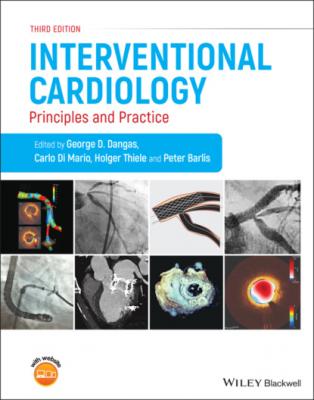Interventional Cardiology. Группа авторов
Читать онлайн.| Название | Interventional Cardiology |
|---|---|
| Автор произведения | Группа авторов |
| Жанр | Медицина |
| Серия | |
| Издательство | Медицина |
| Год выпуска | 0 |
| isbn | 9781119697381 |
Serum markers correlated to plaque inflammation
Numerous studies have correlated different serologic biomarkers with cardiovascular disease [171–174] leading to a rapid increase in the number of biomarkers available (Table 1.2). These biomarkers are useful in that they can identify a population at risk of an acute ischemic event and detect the presence of so called vulnerable plaques and/or vulnerable patients [175,176]. Ideally, a biomarker must have certain characteristics to be a potential predictor of incident or prevalent vascular disease. Measurements have to be reproducible in multiple independent samples, the method for determination should be standardized, variability controlled, and the sensitivity and specificity should be good. In addition, the biomarker should be independent from other established risk markers, substantively improve the prediction of risk with established risk factors, be associated with cardiovascular events in multiple population cohorts and clinical trials, and the cost of the assays has to be acceptable. Finally, to be clinically useful a biomarker should correctly reflect the underlying biological process associated with plaque burden and progression.
Traditional biomarkers for cardiovascular risk include low‐density lipoprotein (LDL) cholesterol and glucose. However, 50% of heart attacks and strokes occur in individuals that have normal LDL cholesterol, and 20% of major adverse events occur in patients with no accepted risk factors [177]. Therefore, in light of changing atherosclerotic models, vulnerable blood may be better described as blood that has an increased level of activity of plasma determinants of plaque progression and rupture. In the past decade, the potential role of different micro‐RNAs (miRNAs) in the cardiovascular system biomarkers has been widely recognised. Stable extracellular miRNAs circulate in the bloodstream and might serve as novel diagnostic markers for a wide range of cardiovascular diseases and risk factors, such as myocardial infarction [178,179], heart failure [180], coronary atherosclerotic disease [181], hypertension [182], and type 2 diabetes mellitus [183]. It is to be expected that combining multiple miRNAs into a single miRNA profile may provide improved accuracy.
Table 1.2 Serologic markers of vulnerable plaque/patient.
| ReflectingMetabolic and Immune Disorders | ReflectingHypercoagulability | ReflectingComplex Atherosclerotic Plaque |
|---|---|---|
| Abnormal lipoprotein profile (i.e. high LDL, low HDL, lipoprotein [a], etc.)Non specific markers of inflammation (hs‐CRP, CD40L, ICAM‐1, VCAM, leukocytosis and other immuno‐related serologic markers which may not be specific for atherosclerosis and plaque inflammationSerum markers of metabolic syndrome (diabetes or hypertriglyceridemia)Specific markers of immune activation (i.e. anti‐LDL antibody, anti heat shock protein (HSP) antibodyMarkers of lipid peroxidation (i.e. ox‐LDL and ox‐HDL)HomocysteinePAPP‐ACirculating apoptosis markers (i.e. Fas/Fas ligand)ADMA/DDAH (i.e. asymmetric dimethylarginine/dimethylarginine dimethylaminohydrolase)Circulating NEFA (nonesterified fatty acids) | Markers of blood hypercoagulability (i.e. fibrinogen, D‐dimer, factor V of Leiden)Increased platelet activation and aggregation (i.e. gene polymorphism of platelet glycoproteins IIb/IIIa, Ia/IIa, and Ib/IX)Increased coagulation factors (i.e. clotting of factors V, VII, VIII, XIII, von Willebrand factor)Decreased anticoagulation factors (i.e. protein S and C, thrombomodulin, antithrombin III)Decreased endogenous fibrinolysis activity (i.e. reduced tissue plasminogen activator, increased type I plasminogen activator (PAI), PAI polymorphisms)Prothrombin mutation (i.e. G20210A)Thrombogenic factors (i.e. anticardiolipin antibodies, thrombocytosis, sickle cell disease, diabetes, hypercholesterolemia)Transient hypercoagulability (i.e. smoking, dehydration, infection) | Morphology/StructureCap thicknessLipid core sizePercentage stenosisRemodelling (positive vs. negative)Color (yellow, red)Collagen content vs. lipid contentCalcification burden and patternShear stress Activity/functionPlaque inflammation (macrophage density, rate of monocyte and activated T cells infiltration)Endothelial denudation or dysfunction (local nitric oxide production, anti/procoaugulation properties of the endothelium)Plaque oxidative stressSuperficial platelet aggregation and fibrin depositionRate of apoptosis (apoptosis protein markers, microsatellite)Angiogenesis, leaking vasa vasorum, intraplaque haemorrhageMatrix metalloproteinases (MMP‐2, ‐3, ‐9)Microbial antigens (Chlamydia pneumoniae) Temperature Pan Arterial Transcoronary gradient of vulnerability biomarkersTotal calcium burdenTotal coronary vasoreactivityTotal arterial plaque burden (intima media thickness) |
In this context, proposed biomarkers fall into nine general categories: inflammatory markers, markers for oxidative stress, markers of plaque erosion and thrombosis, lipid‐associated markers, markers of endothelial dysfunction, metabolic markers, markers of neovascularization, and genetic markers. The last six biomarker categories are not treated in the presented chapter but only listed in Table 1.1. As mentioned earlier, some of these markers may indeed reflect the natural history of atherosclerotic plaque growth and may not be directly related to an increased risk of cardiovascular events. The best outcomes may be achieved by a panel of markers that will capture all of the different processes involved in plaque progression and plaque rupture, and that will enable clinicians to quantify an individual patient’s true cardiovascular risk. In all likelihood, a combination of genetic (representing heredity) and serum markers (representing the net interaction between heredity and environment) will ultimately be the ones that should be utilized in primary prevention. Finally, different non‐invasive and invasive imaging techniques may be coupled with biomarkers detection to increase the specificity, sensitivity, and overall predictive value of each potential diagnostic technique.
Markers of inflammation
Markers of inflammation include C‐reactive protein (CRP), inflammatory cytokines soluble CD40L (sCD40L), soluble vascular adhesion molecules (sVCAM), and tumour necrosis factor (TNF).
C‐reactive protein is a circulating pentraxin that plays a major role in the human innate immune response [184] and provides a stable plasma biomarker for low‐grade systemic inflammation. C‐reactive protein is produced predominantly in the liver as part of the acute phase response. However, CRP is also expressed in smooth muscle cells within diseased atherosclerotic arteries [185] and has been implicated in multiple aspects of atherogenesis and plaque vulnerability, including expression of adhesion molecules, induction of nitric oxide, altered complement function,
